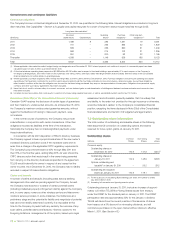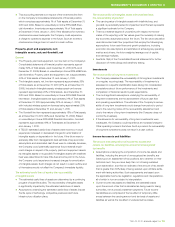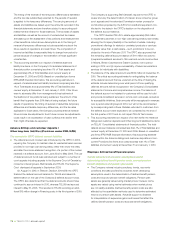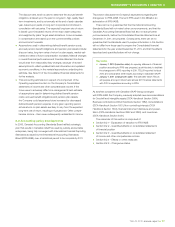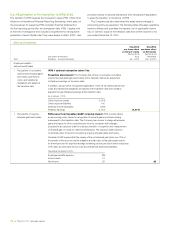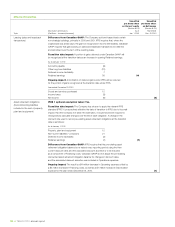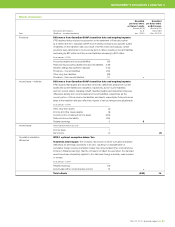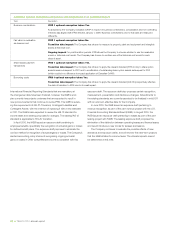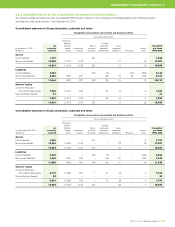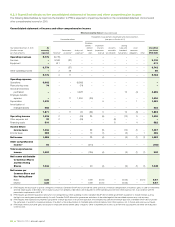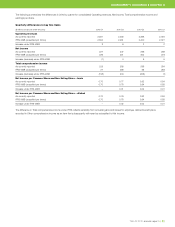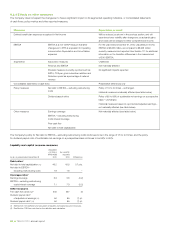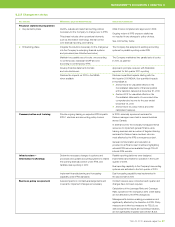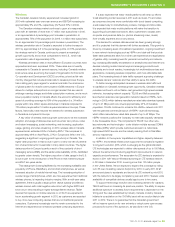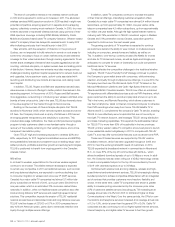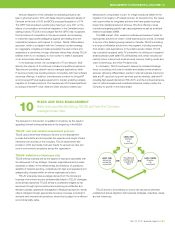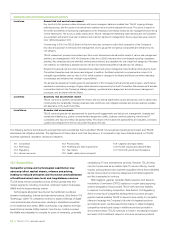Telus 2010 Annual Report Download - page 86
Download and view the complete annual report
Please find page 86 of the 2010 Telus annual report below. You can navigate through the pages in the report by either clicking on the pages listed below, or by using the keyword search tool below to find specific information within the annual report.
82 . TELUS 2010 annual report
exposure draft. The exposure draft also proposes certain recognition,
measurement, presentation and disclosure changes. Amendments to
the existing standards are currently expected to be finalized in mid-2011
with an unknown effective date for the Company.
In June 2010, the IASB issued an exposure draft pertaining to
revenue recognition as part of the joint revenue project with the U.S.
Financial Accounting Standards Board (FASB). In August 2010, the
IASB issued an exposure draft pertaining to leases as part of the joint
leasing project with FASB. The leasing exposure draft proposes the
elimination of the distinction between operating leases and finance leases
and would introduce a new model for lessees and lessors.
The Company continues to evaluate the possible effects of new
standards and exposure drafts, and will monitor the near-term projects
that the IASB initiates for income taxes. The ultimate impacts cannot
be determined at this time.
International Financial Reporting Standards that are mandatory at
the changeover date have been finalized, however, the IASB’s work
plan currently has projects underway that are expected to result in
new pronouncements that continue to evolve IFRS. The IASB is review-
ing the requirements of IAS 37 Provisions, Contingent Liabilities and
Contingent Assets, with the intention of replacing it with a new standard
in 2011. The IASB is also expected to review the IAS 12 standard for
income taxes and develop proposals for changes. The existing IAS 12
standard is applicable to TELUS’ transition.
In April 2010, the IASB issued an exposure draft pertaining to
employee benefits, specifically the recognition of actuarial gains or losses
for defined benefit plans. The exposure draft proposes to eliminate the
corridor method for recognition of actuarial gains or losses. The Company’s
elected accounting policy choice of recognizing ongoing actuarial
gains or losses in Other comprehensive income is consistent with this
Additional optional exemptions and policies with insignificant or no quantified impact
Topic Description
Business combinations IFRS 1 optional exemption taken: Yes.
As adopted by the Company, Canadian GAAP in respect of business combinations, consolidation and non-controlling
interests was aligned with IFRS effective January 1, 2009. Business combinations prior to that date are measured
differently.
Fair value or revaluation
as deemed cost
IFRS 1 optional exemption taken: No.
Transition date impact: The Company has chosen to measure its property, plant and equipment and intangible
assets at historical cost.
Ongoing impact: For post-transition periods, IFRS allows the Company to choose whether to use the revaluation
model or historical cost model. The Company has chosen to continue use of the historical cost model for each
class of asset.
Share-based payment
transactions
IFRS 1 optional exemption taken: Yes.
Transition date impact: The Company has chosen to apply the relevant standard (IFRS 2) only to share option
awards made subsequent to 2001 and to modification of outstanding share option awards subsequent to 2001
(which results in no difference from past application of Canadian GAAP).
Borrowing costs IFRS 1 optional exemption taken: Yes.
Transition date impact: The Company has chosen to apply the relevant standard (IAS 23) prospectively effective
the date of transition to IFRS due to its small impact.


